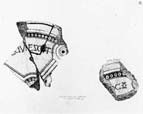Select a site alphabetically from the choices shown in the box below. Alternatively, browse sculptural examples using the Forward/Back buttons.
Chapters for this volume, along with copies of original in-text images, are available here.
Object type: Incomplete recumbent grave-marker, in several pieces [1]
Measurements: Unknown
Stone type: Unknown
Plate numbers in printed volume: Pl. 84.429
Corpus volume reference: Vol 1 p. 97-98
(There may be more views or larger images available for this item. Click on the thumbnail image to view.)
A (broad): All comment depends on drawing in Gage (1836). The stone is described as being in five pieces although only four are shown on the drawing. It could have been of a round or half-round form. It appears to have a fine raised outer band, and a plain outlined border enclosing a narrow pelleted band enclosed in double outlines. This is cut by the terminals of a cross, type G1, with a dot centre surrounded by three irregular circles. The cross-arm is incised with a median line and in the centre is a wide circular hole surrounded by a pelleted band. The quadrants of the cross appear to have contained Latin inscriptions in Anglo-Saxon capitals:
Fragments a–c: II — EQ] V [I] ES [CI] T II
Fragment d: — C O II
The completion of the inscription poses difficulties. Okasha (1971, 76) suggests HIC IN SEPULCHRO REQUIESCIT CORPORE. Scott (1956, 200) considered that fragment d must have formed the end of a word, and so cannot have been part of the word corpore. There is no reason to suppose that the word division would always have respected the division into quadrants however. This stone is of a more elaborate form than any of the other small inscribed stones from Hartlepool or Lindisfarne and parallels the `Herebericht' slab (Monkwearmouth 5). This piece is also the most elaborately decorated of the small inscribed stones. It appears to have been carved in a combination of incised and low relief ornament. All these factors seem to put it late in the series. (See also Discussion under no. 8.)



